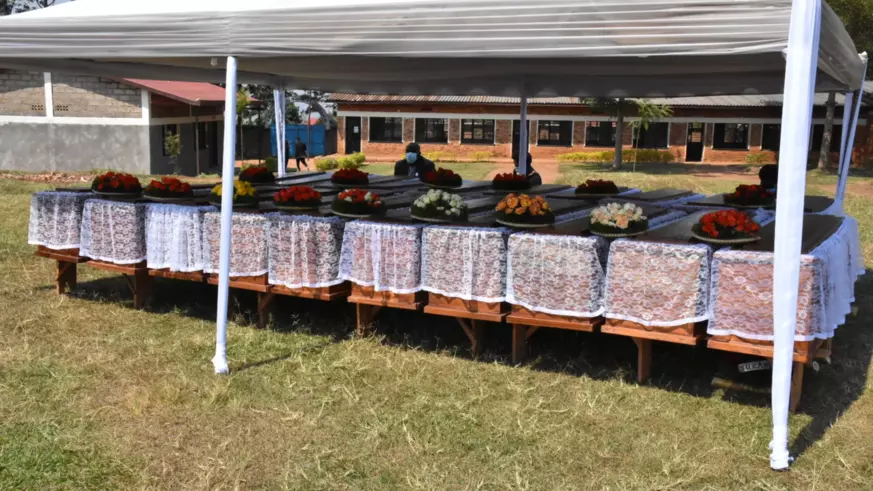
By Jean de Dieu Nsabimana, The New Times
Genocide survivors and the leadership of Gatsibo District on Saturday, August 29 laid to rest 5,269 victims of the 1994 Genocide against Tutsi, in the upgraded memorial site of Kiziguro.
Many of the victims were exhumed from a mass grave that was in the premises of the Kiziguro Genocide memorial. Others numbering 254 were relocated from Bugarura memorial while others were relocated from homes. This makes Kiziguro memorial home to 20,123 victims.
April 11, 1994 is remembered as the darkest day for the Tutsi who lived in Gatsibo, which was Murambi Commune at the time. It is on this day that those who had sought refuge at Kiziguro Catholic Church and surrounding places were exterminated, with many being dumped in a nearby 24-metres hole that had been dug in the 1970s.
Some were even dumped in there alive. Jacques Ntagarama was one of them. He testified that after they were thrown into the pit, the Interahamwe threw grenades at them, to ensure no one survived.
“We were like 15 people who were alive in the pit. We were there for two nights and dead bodies had started decomposing, it was so difficult to stay alive. Someone then threw a hoe inside which they used to dig to cover the dead with soil.”
He said they lived in the hole until April 16, when RPF soldiers came and gave them ropes. Only 11 survived the mass grave but another of them died immediately after getting out.
Only five are still alive today.
“Inkotanyi have healed us, despite the depth of out wounds, we’re at least alive,” he added.
The chairperson of Ibuka in Gatsibo District, Jean Nepo Sibomana, said the exhuming of the remains from this mass grave took over a month between October and November last year.
He decried the slow pace of reconciliation by the perpetrators of the Genocide but urged survivors to forgive regardless.
“Survivors are willing to forgive, despite all we went through. Let’s take that step, and forgive those who did wrong to us. I urge all the survivors to forgive even if few perpetrators are seeking forgiveness,” he said.
Sibomana also demands that the Catholic Church allows establishment of a monument at the church, to show that thousands were killed inside and outside the church building.
He also mentioned that trauma is worrying nowadays, and suggested an institution at the provincial level aimed to help survivors heal trauma.
Jean Damascene Bizimana, the Executive Secretary of the National Commission to fight against the Genocide (CNLG), said people must recognise that genocide took place, but they should also be thankful to what happened in its aftermath, with the country becoming safer every day.
“Let’s be happy about the fact that after the RPF Inkotanyi liberated our country, justice did its work, including bringing to book the genocidaires behind the massacre of Tutsis in Gatsibo and Nyagatare districts,” he said.
Jean-Baptiste Gatete was the most notorious genocidaire in the former Murambi Commune, in which he served as bourgmestre. On Oct. 09, 2012, he was given a 40-year sentence, after the appeal for the life sentence he had been given.
Other genocidaires include Onesphore Rwabukombe, who was Bourgmestre of Muvumba Commune. On April 18, 2014, a court in Frankfurt, Germany found him guilty of complicity in killings of Tutsi at Kiziguro Parish and handed him 14 year sentence which he appealed.
Instead, the appeal court overturned his sentence to hand him a life sentence in 2015.
The appeal court found that he was not just an accomplice but a mastermind of the killings of Tutsis in Kiziguro and beyond.”
Eastern Province Governor Emmanuel Gasana noted that giving decent burial to victims is according them respect they deserve.
He added that current Rwanda is new and is built on unity of Rwandans because Rwandans have chosen to be one.
“Genocide will never happen again in Rwanda; that is our mission. Youth have a task to build the nation on that mindset, then that is how all of us will build the country we want,” he said.
Construction of the new graves at Kiziguro memorial site as well as a building that will serve as an archives centre gallery showcasing history related to Genocide against the Tutsi in former Murambi Commune, cost over Rwf629m.
